battery DODGE VIPER 2008 ZB II / 2.G Owners Manual
[x] Cancel search | Manufacturer: DODGE, Model Year: 2008, Model line: VIPER, Model: DODGE VIPER 2008 ZB II / 2.GPages: 303, PDF Size: 2.65 MB
Page 10 of 303
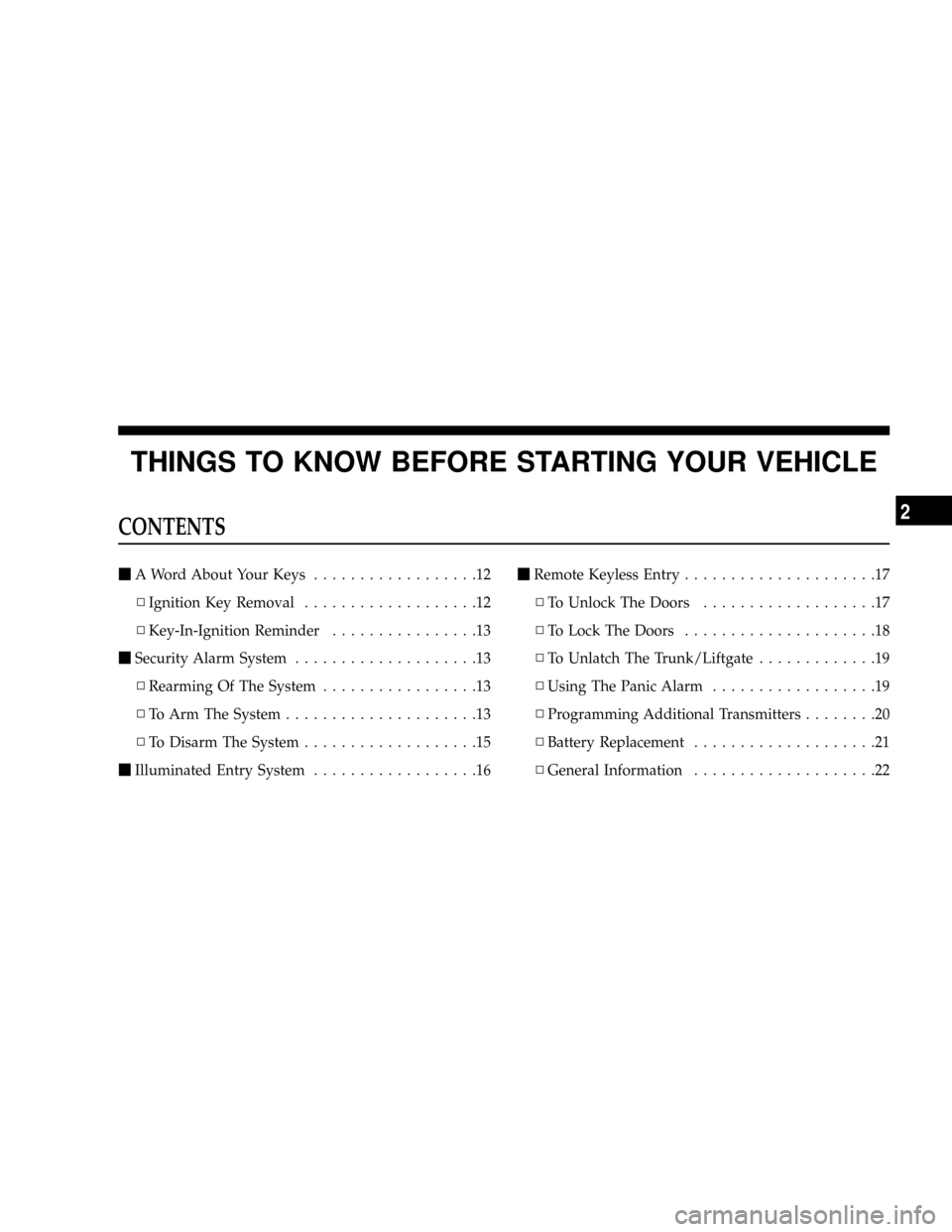
THINGS TO KNOW BEFORE STARTING YOUR VEHICLE
CONTENTS
mA Word About Your Keys..................12
NIgnition Key Removal...................12
NKey-In-Ignition Reminder................13
mSecurity Alarm System....................13
NRearming Of The System.................13
NTo Arm The System.....................13
NTo Disarm The System...................15
mIlluminated Entry System..................16mRemote Keyless Entry.....................17
NTo Unlock The Doors...................17
NTo Lock The Doors.....................18
NTo Unlatch The Trunk/Liftgate.............19
NUsing The Panic Alarm..................19
NProgramming Additional Transmitters........20
NBattery Replacement....................21
NGeneral Information....................22
2
Page 22 of 303
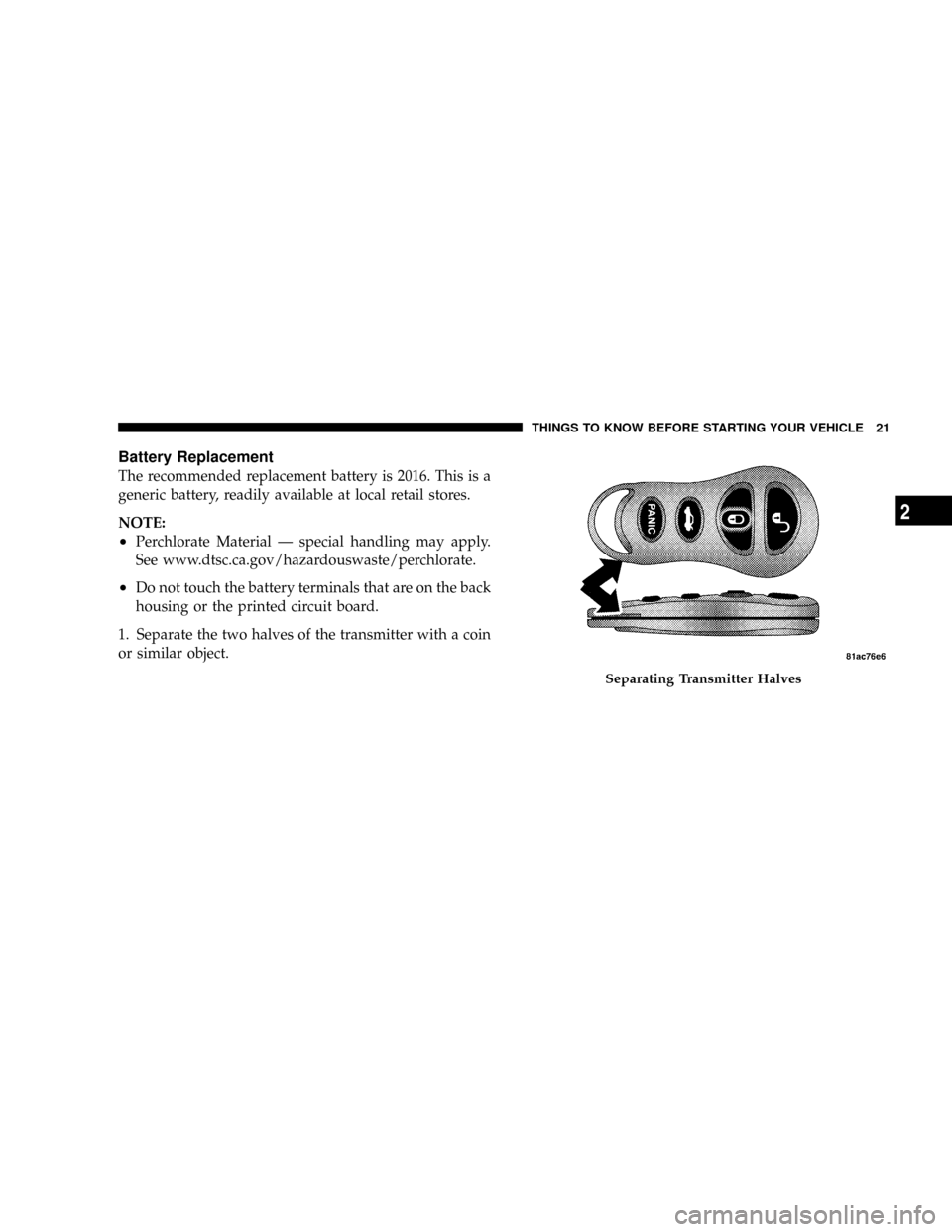
Battery Replacement
The recommended replacement battery is 2016. This is a
generic battery, readily available at local retail stores.
NOTE:
²Perchlorate Material Ð special handling may apply.
See www.dtsc.ca.gov/hazardouswaste/perchlorate.
²Do not touch the battery terminals that are on the back
housing or the printed circuit board.
1. Separate the two halves of the transmitter with a coin
or similar object.
Separating Transmitter Halves
THINGS TO KNOW BEFORE STARTING YOUR VEHICLE 21
2
Page 23 of 303
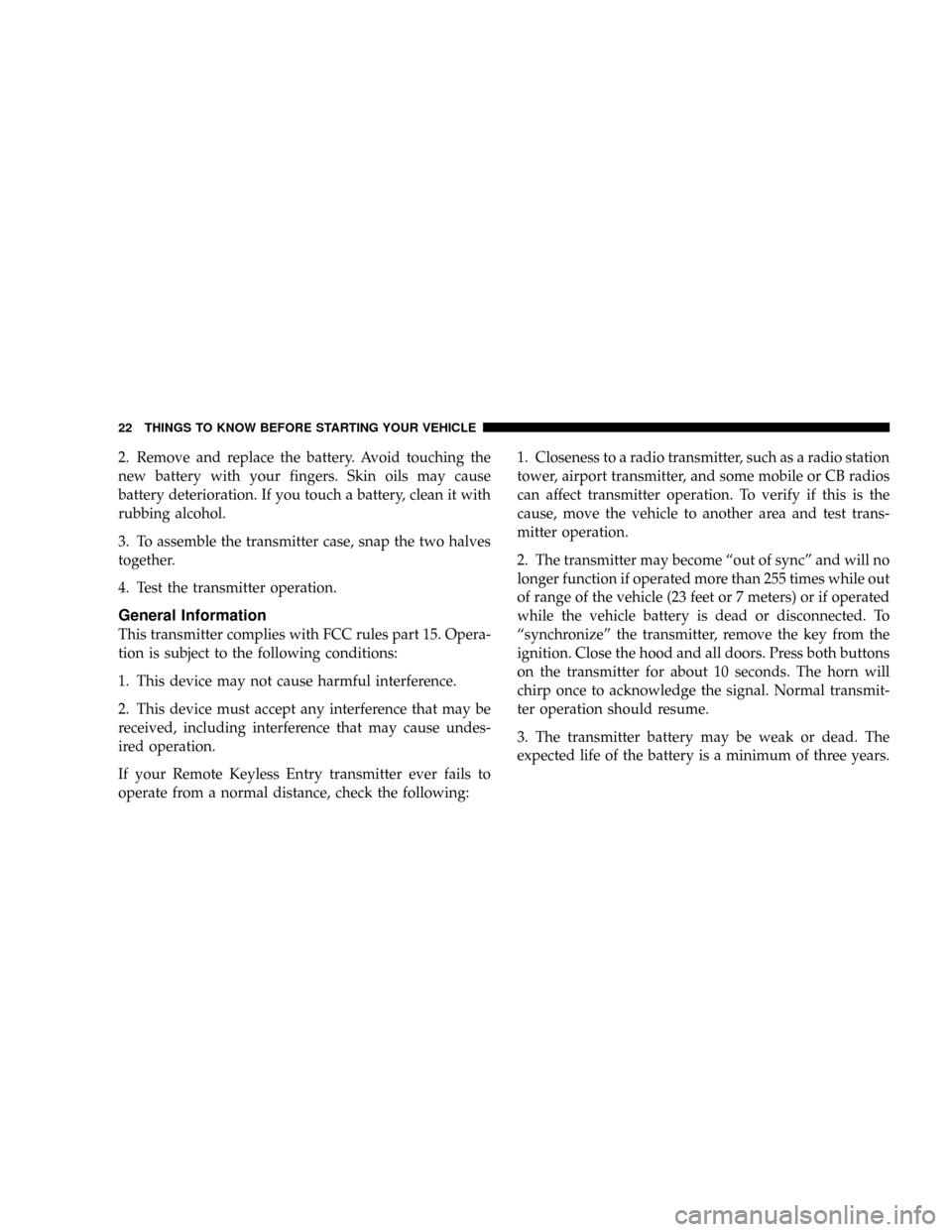
2. Remove and replace the battery. Avoid touching the
new battery with your fingers. Skin oils may cause
battery deterioration. If you touch a battery, clean it with
rubbing alcohol.
3. To assemble the transmitter case, snap the two halves
together.
4. Test the transmitter operation.
General Information
This transmitter complies with FCC rules part 15. Opera-
tion is subject to the following conditions:
1. This device may not cause harmful interference.
2. This device must accept any interference that may be
received, including interference that may cause undes-
ired operation.
If your Remote Keyless Entry transmitter ever fails to
operate from a normal distance, check the following:1. Closeness to a radio transmitter, such as a radio station
tower, airport transmitter, and some mobile or CB radios
can affect transmitter operation. To verify if this is the
cause, move the vehicle to another area and test trans-
mitter operation.
2. The transmitter may become ªout of syncº and will no
longer function if operated more than 255 times while out
of range of the vehicle (23 feet or 7 meters) or if operated
while the vehicle battery is dead or disconnected. To
ªsynchronizeº the transmitter, remove the key from the
ignition. Close the hood and all doors. Press both buttons
on the transmitter for about 10 seconds. The horn will
chirp once to acknowledge the signal. Normal transmit-
ter operation should resume.
3. The transmitter battery may be weak or dead. The
expected life of the battery is a minimum of three years.
22 THINGS TO KNOW BEFORE STARTING YOUR VEHICLE
Page 63 of 303
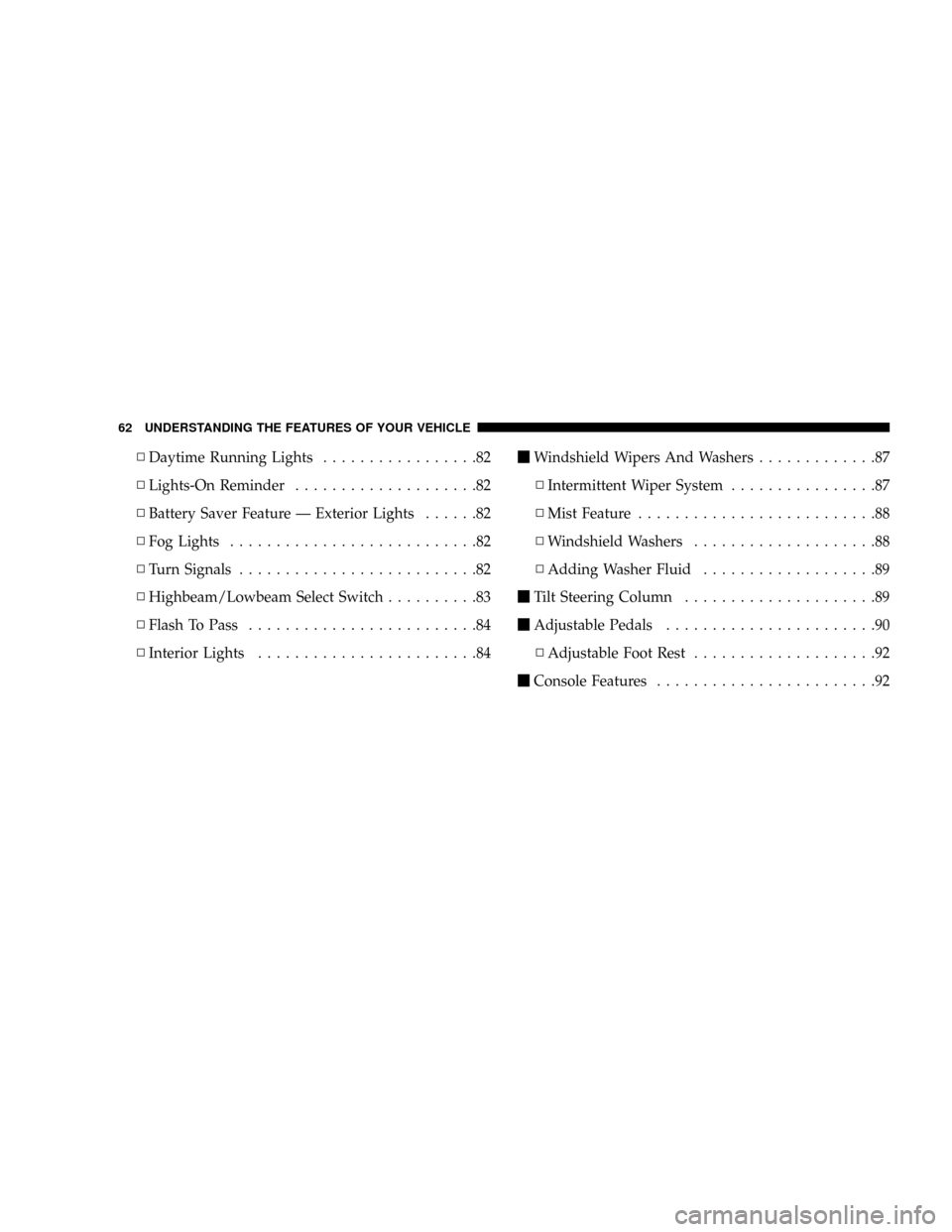
NDaytime Running Lights.................82
NLights-On Reminder....................82
NBattery Saver Feature Ð Exterior Lights......82
NFog Lights...........................82
NTurn Signals..........................82
NHighbeam/Lowbeam Select Switch..........83
NFlash To Pass.........................84
NInterior Lights........................84mWindshield Wipers And Washers.............87
NIntermittent Wiper System................87
NMist Feature..........................88
NWindshield Washers....................88
NAdding Washer Fluid...................89
mTilt Steering Column.....................89
mAdjustable Pedals.......................90
NAdjustable Foot Rest....................92
mConsole Features........................92
62 UNDERSTANDING THE FEATURES OF YOUR VEHICLE
Page 83 of 303
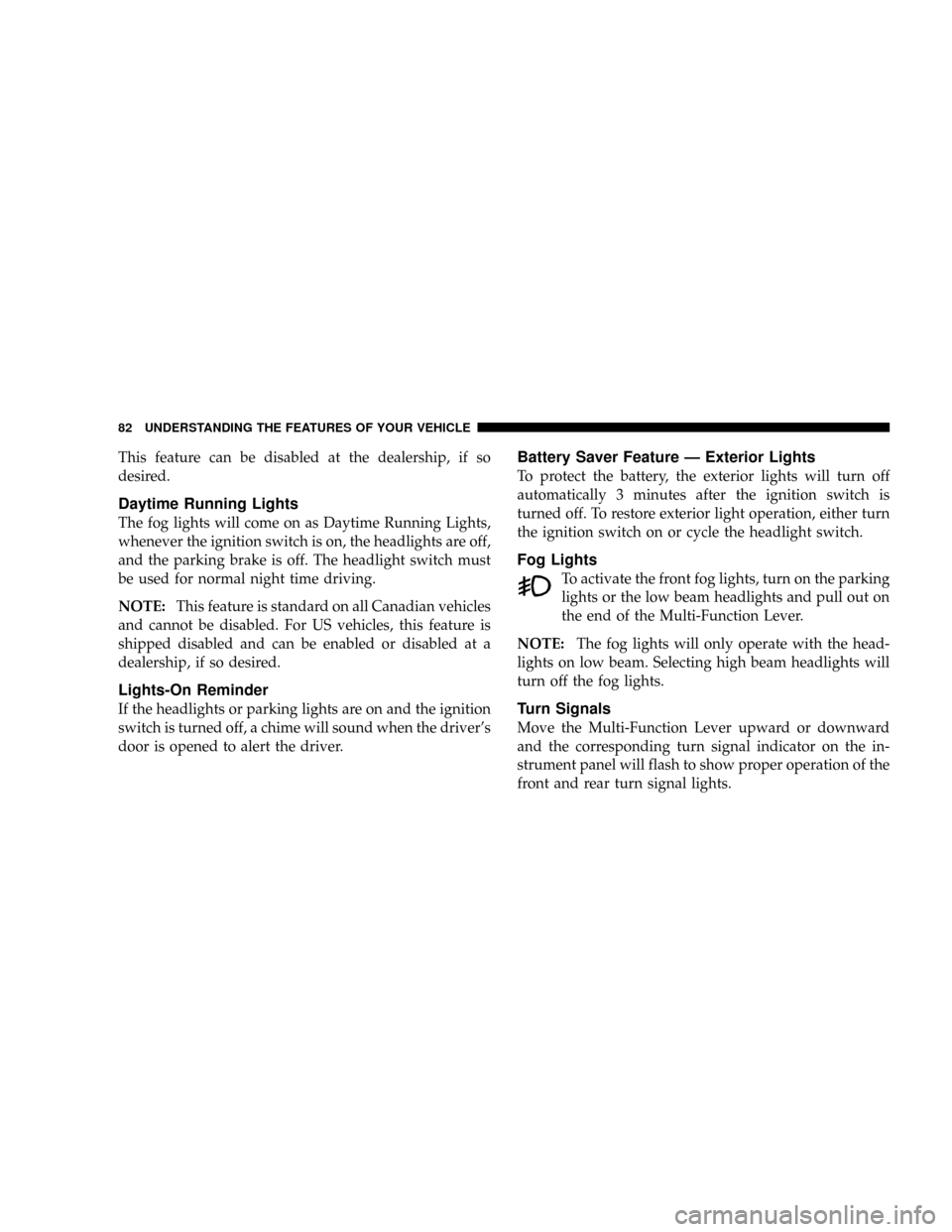
This feature can be disabled at the dealership, if so
desired.
Daytime Running Lights
The fog lights will come on as Daytime Running Lights,
whenever the ignition switch is on, the headlights are off,
and the parking brake is off. The headlight switch must
be used for normal night time driving.
NOTE:This feature is standard on all Canadian vehicles
and cannot be disabled. For US vehicles, this feature is
shipped disabled and can be enabled or disabled at a
dealership, if so desired.
Lights-On Reminder
If the headlights or parking lights are on and the ignition
switch is turned off, a chime will sound when the driver's
door is opened to alert the driver.
Battery Saver Feature Ð Exterior Lights
To protect the battery, the exterior lights will turn off
automatically 3 minutes after the ignition switch is
turned off. To restore exterior light operation, either turn
the ignition switch on or cycle the headlight switch.
Fog Lights
To activate the front fog lights, turn on the parking
lights or the low beam headlights and pull out on
the end of the Multi-Function Lever.
NOTE:The fog lights will only operate with the head-
lights on low beam. Selecting high beam headlights will
turn off the fog lights.
Turn Signals
Move the Multi-Function Lever upward or downward
and the corresponding turn signal indicator on the in-
strument panel will flash to show proper operation of the
front and rear turn signal lights.
82 UNDERSTANDING THE FEATURES OF YOUR VEHICLE
Page 86 of 303
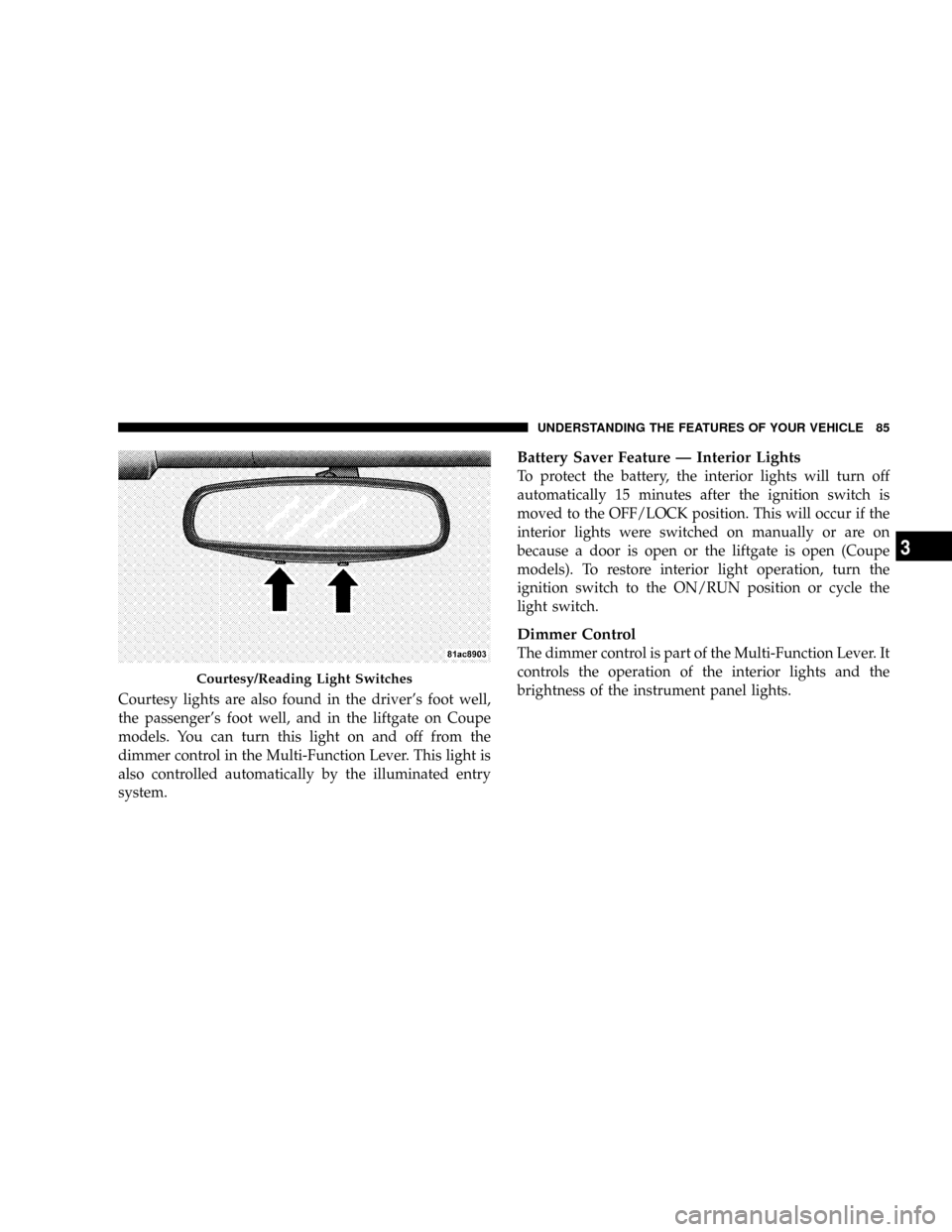
Courtesy lights are also found in the driver's foot well,
the passenger's foot well, and in the liftgate on Coupe
models. You can turn this light on and off from the
dimmer control in the Multi-Function Lever. This light is
also controlled automatically by the illuminated entry
system.
Battery Saver Feature Ð Interior Lights
To protect the battery, the interior lights will turn off
automatically 15 minutes after the ignition switch is
moved to the OFF/LOCK position. This will occur if the
interior lights were switched on manually or are on
because a door is open or the liftgate is open (Coupe
models). To restore interior light operation, turn the
ignition switch to the ON/RUN position or cycle the
light switch.
Dimmer Control
The dimmer control is part of the Multi-Function Lever. It
controls the operation of the interior lights and the
brightness of the instrument panel lights.
Courtesy/Reading Light Switches
UNDERSTANDING THE FEATURES OF YOUR VEHICLE 85
3
Page 100 of 303
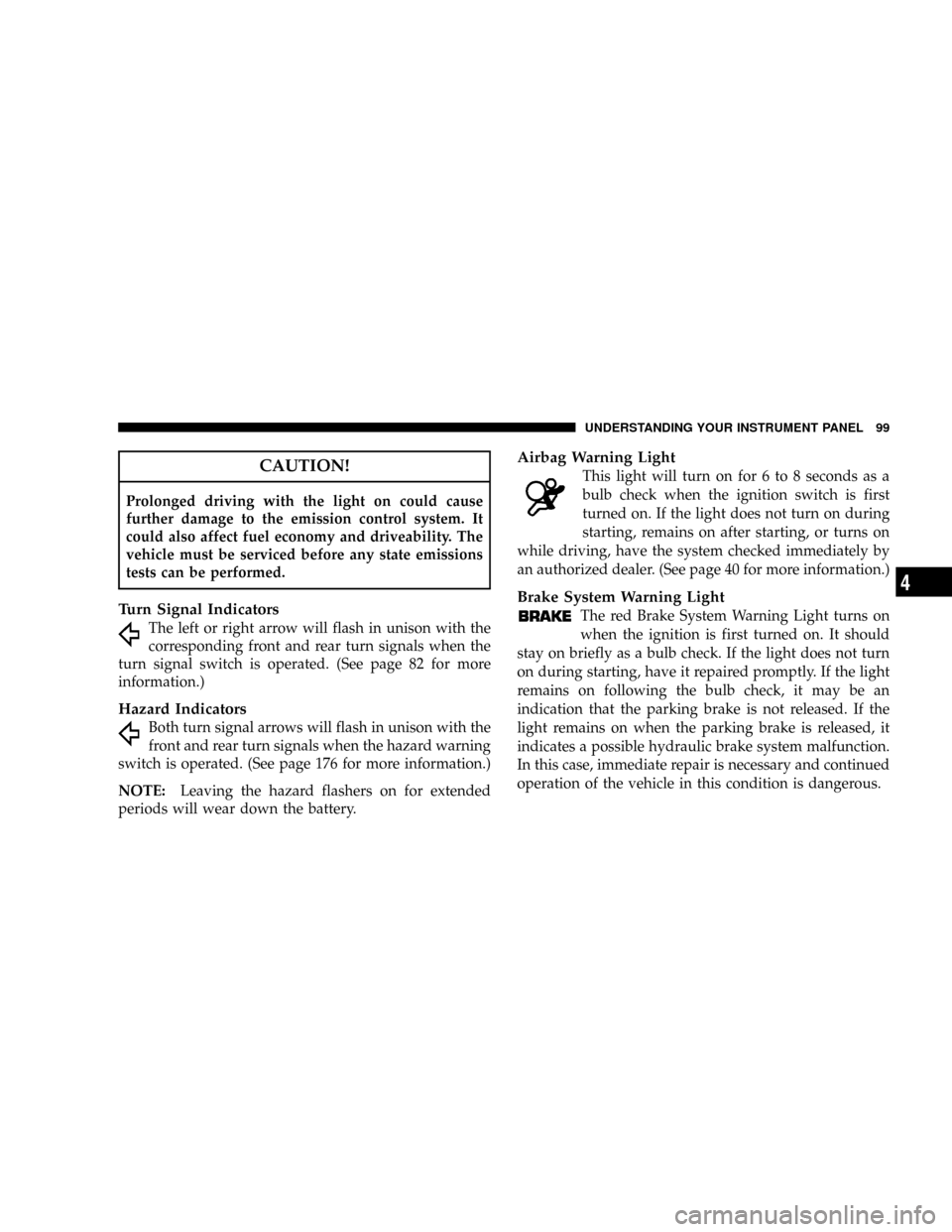
CAUTION!
Prolonged driving with the light on could cause
further damage to the emission control system. It
could also affect fuel economy and driveability. The
vehicle must be serviced before any state emissions
tests can be performed.
Turn Signal Indicators
The left or right arrow will flash in unison with the
corresponding front and rear turn signals when the
turn signal switch is operated. (See page 82 for more
information.)
Hazard Indicators
Both turn signal arrows will flash in unison with the
front and rear turn signals when the hazard warning
switch is operated. (See page 176 for more information.)
NOTE:Leaving the hazard flashers on for extended
periods will wear down the battery.
Airbag Warning Light
This light will turn on for 6 to 8 seconds as a
bulb check when the ignition switch is first
turned on. If the light does not turn on during
starting, remains on after starting, or turns on
while driving, have the system checked immediately by
an authorized dealer. (See page 40 for more information.)
Brake System Warning Light
The red Brake System Warning Light turns on
when the ignition is first turned on. It should
stay on briefly as a bulb check. If the light does not turn
on during starting, have it repaired promptly. If the light
remains on following the bulb check, it may be an
indication that the parking brake is not released. If the
light remains on when the parking brake is released, it
indicates a possible hydraulic brake system malfunction.
In this case, immediate repair is necessary and continued
operation of the vehicle in this condition is dangerous.
UNDERSTANDING YOUR INSTRUMENT PANEL 99
4
Page 136 of 303

If Engine Fails to Start
CAUTION!
To prevent damage to the starter, do not crank the
engine for more than 15 seconds at a time. Wait 10 to
15 seconds before trying again.
WARNING!
²Never pour fuel or other flammable liquid into the
throttle body air inlet opening in an attempt to
start the vehicle. This could result in flash fire
causing serious personal injury.
²Do not attempt to push or tow your vehicle to get
it started. Unburned fuel could enter the catalytic
converter and once the engine has started, ignite
and damage the converter and vehicle. If the
vehicle has a discharged battery, booster cables
may be used to obtain a start from a booster
battery or the battery in another vehicle. This type
of start can be dangerous if done improperly, so
follow this procedure carefully. See section 6 of
this manual for jump starting instructions.
STARTING AND OPERATING 135
5
Page 177 of 303

HAZARD WARNING FLASHER
The flasher switch is on the top of the steering
column, just behind the steering wheel. Depress
the flasher button and all front and rear directional
signals will flash. Depress the flasher button again to turn
off the flashers.Do not use this emergency warning system when the
vehicle is in motion. Use it when your vehicle is disabled
and is creating a safety hazard for other motorists.
If it is necessary to leave the vehicle to go for service, the
flasher system will continue to operate with the ignition
key removed.
NOTE:With extended use, the flasher may run down
your battery.
IF YOUR ENGINE OVERHEATS
In any of the following situations, you can reduce the
potential for overheating by taking the appropriate ac-
tion.
²On the highways ÐSlow down and use the highest
gear possible.
²In city traffic ÐWhile stopped, put the transmission
in neutral, but do not increase engine idle speed.
Hazard Flasher Switch
176 WHAT TO DO IN EMERGENCIES
Page 187 of 303
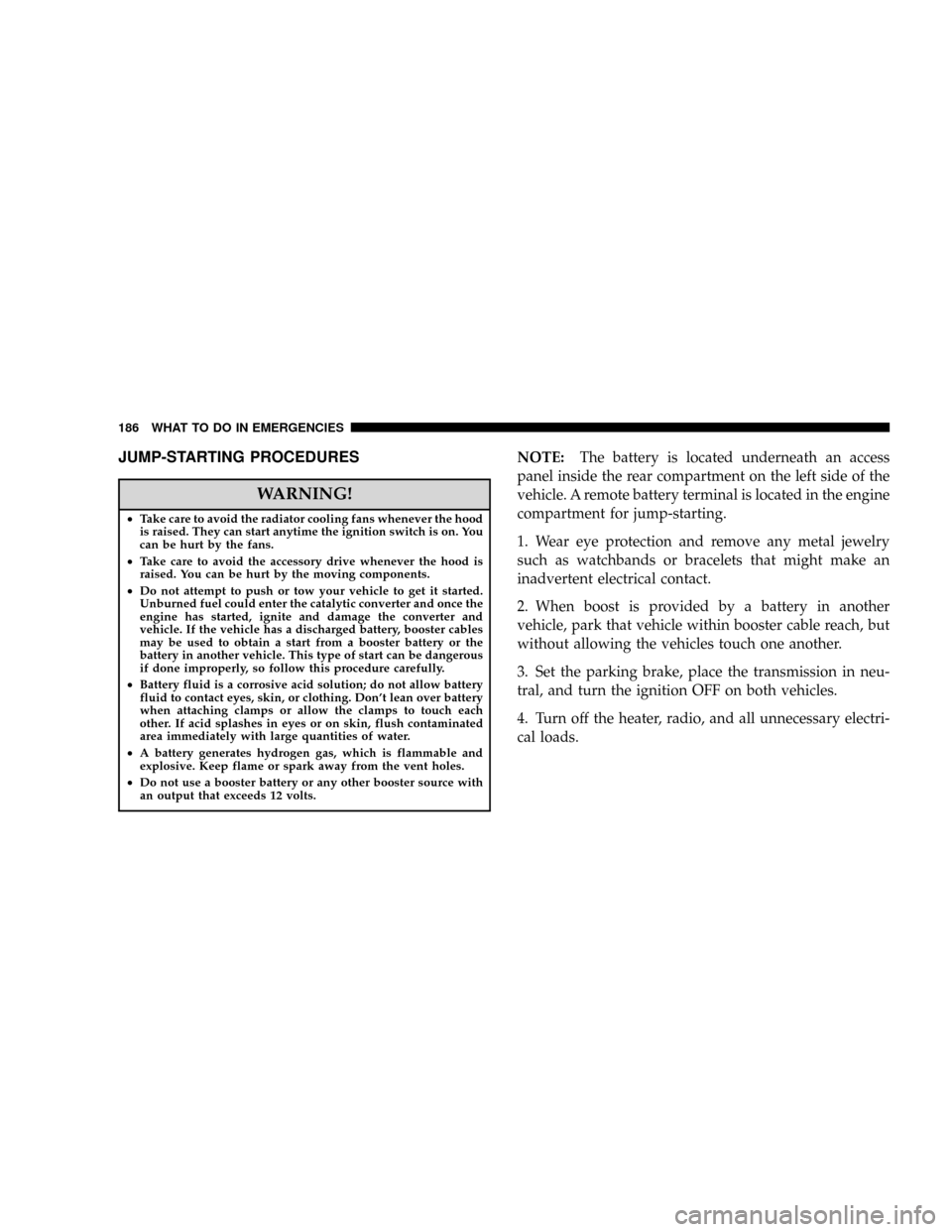
JUMP-STARTING PROCEDURES
WARNING!
²Take care to avoid the radiator cooling fans whenever the hood
is raised. They can start anytime the ignition switch is on. You
can be hurt by the fans.
²Take care to avoid the accessory drive whenever the hood is
raised. You can be hurt by the moving components.
²Do not attempt to push or tow your vehicle to get it started.
Unburned fuel could enter the catalytic converter and once the
engine has started, ignite and damage the converter and
vehicle. If the vehicle has a discharged battery, booster cables
may be used to obtain a start from a booster battery or the
battery in another vehicle. This type of start can be dangerous
if done improperly, so follow this procedure carefully.
²Battery fluid is a corrosive acid solution; do not allow battery
fluid to contact eyes, skin, or clothing. Don't lean over battery
when attaching clamps or allow the clamps to touch each
other. If acid splashes in eyes or on skin, flush contaminated
area immediately with large quantities of water.
²A battery generates hydrogen gas, which is flammable and
explosive. Keep flame or spark away from the vent holes.
²Do not use a booster battery or any other booster source with
an output that exceeds 12 volts.
NOTE:The battery is located underneath an access
panel inside the rear compartment on the left side of the
vehicle. A remote battery terminal is located in the engine
compartment for jump-starting.
1. Wear eye protection and remove any metal jewelry
such as watchbands or bracelets that might make an
inadvertent electrical contact.
2. When boost is provided by a battery in another
vehicle, park that vehicle within booster cable reach, but
without allowing the vehicles touch one another.
3. Set the parking brake, place the transmission in neu-
tral, and turn the ignition OFF on both vehicles.
4. Turn off the heater, radio, and all unnecessary electri-
cal loads.
186 WHAT TO DO IN EMERGENCIES